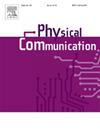Three-dimensional trajectory optimization of rotary-wing UAV with cellular network connectivity based on modified DDPG
IF 2.2
4区 计算机科学
Q3 ENGINEERING, ELECTRICAL & ELECTRONIC
引用次数: 0
Abstract
The integration of cellular network and unmanned aerial vehicles (UAVs) plays a critical role in the development of remote sensing and intelligent monitoring technologies. However, due to the limited onboard energy and the down-tilt characteristics of cellular base station (BS) antennas, UAVs navigating over urban areas still face practical challenges. By investigating the trade-off between UAV flight time and expected interruption time, this paper proposes a deep reinforcement learning (DRL) based joint optimization algorithm for UAV three-dimensional (3D) spatial cruising in dense urban areas. The algorithm enables the UAV to determine an optimal trajectory that navigates through designated waypoints within the cruising space while ensuring the completion of the journey under predefined energy constraints. Unlike traditional discretized trajectory optimization methods, our approach employs a deep deterministic policy gradient (DDPG) network to enable fully continuous and omnidirectional action selection, allowing the UAV to navigate more efficiently while avoiding low-coverage areas. Moreover, the algorithm is further modified through the incorporation of a prioritized experience replay (PER) mechanism and N-step learning method, aimed at enhancing overall performance. Numerical results verify that our proposed method significantly outperforms benchmark algorithms in connectivity-aware UAV path planning, demonstrating clear advantages in achieving robust and reliable aerial communication coverage in dynamic 3D environments.
基于改进DDPG的蜂窝网络连接旋翼无人机三维轨迹优化
蜂窝网络与无人机的融合对遥感和智能监控技术的发展起着至关重要的作用。然而,由于机载能量有限和蜂窝基站(BS)天线的下倾角特性,无人机在城市上空导航仍然面临着实际挑战。通过研究无人机飞行时间与预期中断时间之间的权衡关系,提出了一种基于深度强化学习(DRL)的无人机在密集城区三维空间巡航联合优化算法。该算法使无人机能够确定在巡航空间内通过指定航路点的最佳轨迹,同时确保在预定义的能量约束下完成旅程。与传统的离散轨迹优化方法不同,我们的方法采用深度确定性策略梯度(DDPG)网络来实现完全连续和全方位的行动选择,使无人机能够更有效地导航,同时避开低覆盖区域。此外,通过引入优先体验重放(PER)机制和n步学习方法对算法进行进一步改进,旨在提高整体性能。数值结果验证了我们提出的方法在连通性感知无人机路径规划方面明显优于基准算法,在动态三维环境中实现鲁棒可靠的空中通信覆盖方面具有明显的优势。
本文章由计算机程序翻译,如有差异,请以英文原文为准。
求助全文
约1分钟内获得全文
求助全文
来源期刊

Physical Communication
ENGINEERING, ELECTRICAL & ELECTRONICTELECO-TELECOMMUNICATIONS
CiteScore
5.00
自引率
9.10%
发文量
212
审稿时长
55 days
期刊介绍:
PHYCOM: Physical Communication is an international and archival journal providing complete coverage of all topics of interest to those involved in all aspects of physical layer communications. Theoretical research contributions presenting new techniques, concepts or analyses, applied contributions reporting on experiences and experiments, and tutorials are published.
Topics of interest include but are not limited to:
Physical layer issues of Wireless Local Area Networks, WiMAX, Wireless Mesh Networks, Sensor and Ad Hoc Networks, PCS Systems; Radio access protocols and algorithms for the physical layer; Spread Spectrum Communications; Channel Modeling; Detection and Estimation; Modulation and Coding; Multiplexing and Carrier Techniques; Broadband Wireless Communications; Wireless Personal Communications; Multi-user Detection; Signal Separation and Interference rejection: Multimedia Communications over Wireless; DSP Applications to Wireless Systems; Experimental and Prototype Results; Multiple Access Techniques; Space-time Processing; Synchronization Techniques; Error Control Techniques; Cryptography; Software Radios; Tracking; Resource Allocation and Inference Management; Multi-rate and Multi-carrier Communications; Cross layer Design and Optimization; Propagation and Channel Characterization; OFDM Systems; MIMO Systems; Ultra-Wideband Communications; Cognitive Radio System Architectures; Platforms and Hardware Implementations for the Support of Cognitive, Radio Systems; Cognitive Radio Resource Management and Dynamic Spectrum Sharing.
 求助内容:
求助内容: 应助结果提醒方式:
应助结果提醒方式:


